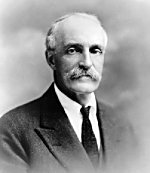About Us | Contact Us | FAQ's | Newsroom
![[design image slice] U.S. Department of Agriculture Forest Service on faded trees in medium light green background](https://webarchive.library.unt.edu/eot2008/20090118204808im_/http://www.fs.fed.us/wo-resources/new/images/rmt-trees-left-usfs.gif)

| Regulations.gov | |
| Employee Search | |
| Information Center | |
| National Offices and Programs | |
| Phone Directory | |
| Regional Offices | |
US Forest Service |
|
History - Gifford Pinchot, First Chief, 1905-1910History Home > Leadership Time Line > Pinchot
 Neither Yale nor any other university offered a degree or even a course in forestry, so Pinchot after graduation decided to study the subject in Nancy, France. After a year of forestry school, he returned to the United States to prepare for his lifelong work and interest. He worked for three years as a resident forester for George Vanderbilt's Biltmore Forest Estate at Asheville, NC. In 1895-97, he became involved with the National Forest Commission created by the National Academy of Sciences to travel through the West to investigate forest public land for possible forest reserves. He was named chief of the Division of Forestry in 1898. The management of the forest reserves was transferred from the Department of the Interior to Agriculture and the new Forest Service in 1905. The chief, or forester, of the new Forest Service was Gifford Pinchot. Pinchot, with President Theodore Roosevelt's willing approval, restructured and professionalized the management of the national forests, as well as greatly increased their area and number. He had a strong hand in guiding the fledgling organization toward the utilitarian philosophy of the "greatest good for the greatest number." Pinchot added the phrase "in the long run" to emphasize that forest management consists of long term decisions. During his period in office, the Forest Service and the national forests grew spectacularly. In 1905 the forest reserves numbered 60 units covering 56 million acres; in 1910 there were 150 national forests covering 172 million acres. The pattern of effective organization and management was set during Pinchot's administration, and "conservation" (an idea he popularized) of natural resources in the broad sense of wise use became a widely known concept and an accepted national goal. Gifford Pinchot is generally regarded as the "father" of American conservation because of his great and unrelenting concern for the protection of the American forests. He was the primary founder of the Society of American Foresters, which first met at his home in Washington in November 1900. He served as chief with great distinction, motivating and providing leadership in the management of natural resources and protection of the national forests. He continued as forester until 1910, when he was fired by President Taft in a controversy over coal claims in Alaska. He was replaced by Henry "Harry" S. Graves. Gifford Pinchot wrote: When I came home [from France] not a single acre of Government, state, or private timberland was under systematic forest management anywhere on the most richly timbered of all continents....When the Gay Nineties began, the common word for our forests was "inexhaustible." To waste timber was a virtue and not a crime. There would always by plenty of timber....The lumbermen...regarded forest devastation as normal and second growth as a delusion of fools....And as for sustained yield, no such idea had ever entered their heads. The few friends the forest had were spoken of, when they were spoken of at all, as impractical theorists, fanatics, or "denudatics," more or less touched in the head. What talk there was about forest protection was no more to the average American that the buzzing of a mosquito, and just about as irritating (Breaking New Ground 1947: 27). Without natural resources life itself is impossible. From birth to death, natural resources, transformed for human use, feed, clothe, shelter, and transport us. Upon them we depend for every material necessity, comfort, convenience, and protection in our lives. Without abundant resources prosperity is out of reach (Breaking New Ground 1947: 505).
|
US Forest Service
Last modified
March 22, 2004
http://www.fs.fed.us